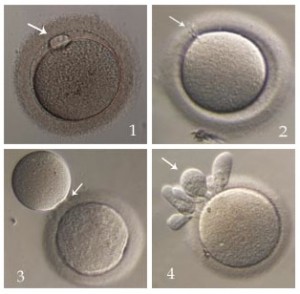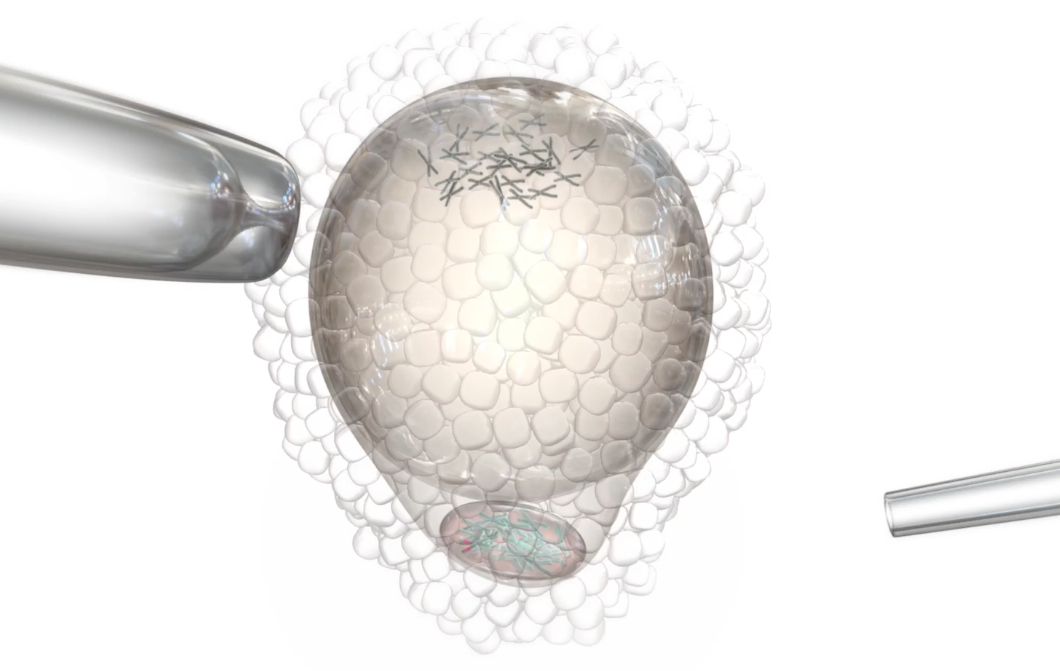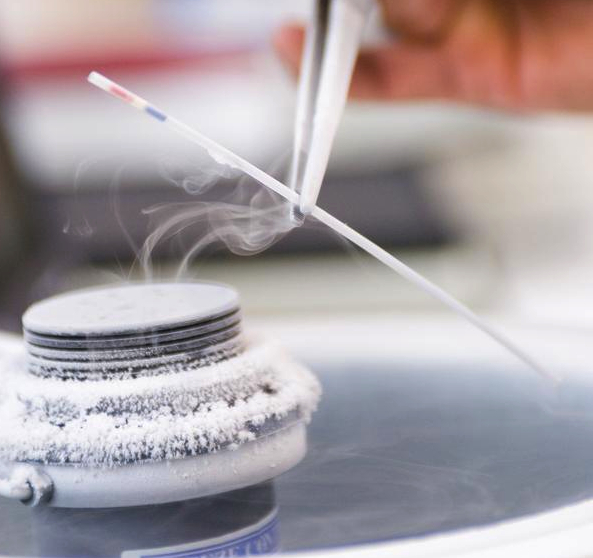The rapid freezing technique of vitrification is set to revolutionise egg donation as a fertility treatment by enabling freeze-storage egg-banking. The cryopreservation of eggs was one of IVF’s continuing challenges until the widespread introduction of vitrification; the older slow freezing methods induced the formation of ice crystals, which could cause damage to several structures of the egg. Thus, as demand for egg donation increases as a treatment for age-related infertility, egg banking with vitrification can theoretically provide a large pool of donor eggs without the present need for collection, fertilisation and transfer in a “fresh” treatment cycle (in which the donor and recipient’s cycles are hormonally synchronised).
Tag: vitrification
Genetic Testing on Eggs Prior to Freezing
Eggs are more prone to genetic abnormalities as a woman ages. These abnormalities lead to increased incidences of infertility, miscarriage and birth defects especially in women over 38 years of age. Egg freezing is a method that suspends egg aging. Since the genetic status of an egg cannot be determined solely on appearance, methods to evaluate eggs using genetic probes have developed and recently tested.
The egg discards DNA at two different times during its development, ovulation and fertilization. The reason for this is to reduce the number of chromosomes to 23 in order to match the 23 chromosomes delivered by the sperm. The discarded DNA (in the form of excess chromosomes) is jettisoned outside of the egg as a small, round pocket called the polar body. Removal of the polar body (biopsy) can provide useful information about the genetic status of the egg. For example, if 23 chromosomes are found in the polar body, the presumption is that a normal count of 23 chromosomes remains in the egg. In contrast, if a number other than 23 is found in the polar body, it implies that an abnormal count remains in the egg and suggests that the egg and ensuing embryo will be genetically abnormal. Testing of the polar body using modern genetic techniques such as Comparative Genomic Hybridization (CGH) or Array-CGH, allows identification of abnormal eggs and can thus help determine the number of genetically normal eggs a woman has to freeze.
However, there are several important limitations to this technology. First, CGH and Array-CGH are still considered experimental, with very little clinical data available. Most clinical data is based on young egg donors and does not reflect the genetic status of eggs from women in their late 30’s. Second, embryos may be genetically abnormal due to mistakes contributed by the egg at the time of the first polar body formation or the second polar body formation; or mistakes contributed by the sperm at the time of fertilization. Therefore, assessing only the first polar body by no means guarantees that a normal embryo will derive. Third, and perhaps most concerning, is the lack of research regarding the effects of biopsying an egg prior to freezing.
We recently completed a small clinical trial wherein we performed polar body biopsy on eggs prior to freezing. We found a high degree of egg damage. The panel of microscopic pictures above demonstrate these changes: the first picture is a normal egg with an intact first polar body (Photo #1); the next picture is an egg after the polar body was removed (Photo #2); the next two pictures show a biopsied egg after freezing and thawing demonstrating egg contents (Photos #3 & #4) extruding through the biopsy slit.  These changes were found on multiple eggs from different patients. These eggs had to be discarded. In addition, many other eggs demonstrated abnormal chromosome segregation after fertilization, and none of the patients achieved a pregnancy.
These changes were found on multiple eggs from different patients. These eggs had to be discarded. In addition, many other eggs demonstrated abnormal chromosome segregation after fertilization, and none of the patients achieved a pregnancy.
At the current time we do not recommend polar body biopsy of eggs prior to freezing until further studies on effectiveness and safety are available.
About the Fertility Clock
The Fertility Clock was developed by Dr. John Jain and Brigitte Mueller as an educational element for the film “My Future Baby: Breakthroughs In Modern Fertility”.
The Fertility Clock provides a simple graphic that can be used to estimate the monthly chance of having a baby.
Age-related decline in natural fertility is due to both decreases in egg count and egg quality; egg quality refers to an egg’s ability to create a chromosomally normal embryo.
As seen in the Fertility Clock, monthly birth rates remain relatively stable through age 35 despite a 90% drop in overall egg counts. Thereafter, birth rates decline more rapidly probably as a result of waning egg quality.
The data used to create the Fertility Clock was taken from landmark works in the fields of Population Research and Developmental Biology.
Using data from historical populations (1) and the most comprehensive study of ovarian reserve to date (2), estimates for monthly birth rates and egg counts were plotted in an age-dependent manner, from birth to menopause.
The rates depicted on the Fertility Clock estimate the experience for most women. As with all biological systems exceptions do exist.
(1) Wallace WH, Kelsey TW. Human ovarian reserve from Conception to the Menopause. PLoS One. 2010 Jan 27;5(1):e8772.
(2) Bongaarts, J. and Potter, R.G. (1983). Fertility, Biology, and Behavior: An analysis of the proximate determinants. New York, NY: Academic Press, Inc.
What is Egg Freezing
What Is Egg Freezing?
Egg freezing is a breakthrough technology that allows women to freeze and store their eggs until a pregnancy is desired. At that time, the eggs are thawed, fertilized and transferred to the uterus as embryos.
Who May Benefit
Many women today are postponing childbearing because they are focused on a career, are returning to school, or because they simply haven’t met the right person. For these women, egg freezing is revolutionary, not just in its technology, but in the life choices it allows them to make.
Over 50,000 reproductive-aged women are diagnosed with cancer each year in the United States. Surgery, chemotherapy and radiation treatments typically lead to infertility by destroying the eggs. While options vary depending on age, type of cancer and cancer-treatment plan, egg freezing can provide these women the opportunity to preserve their fertility.
And finally, egg freezing can be useful for individuals with religious or moral objections to storing frozen embryos that remain following a routine IVF cycle.
How Egg Freezing Works
It takes approximately four to six weeks to complete the egg freezing cycle, which follows the same protocol as IVF. This includes birth control pills and self-administered hormone injections to stimulate the ovaries. Eggs are retrieved and are frozen immediately following retrieval. When embryo transfer is desired, the eggs are thawed, injected with a single sperm to achieve fertilization, and transferred to the uterus as embryos.
Storage
We recommend that at least ten eggs be stored for each pregnancy attempt. For women under thirty-eight years of age, we normally harvest ten to twenty eggs per cycle. Based on our success with embryo freezing, we believe that long-term storage of frozen eggs is possible.
Success Rates
Our most recent frozen egg pregnancy rates are among the highest in the country – approximately 50% with the vitrification method. This figure is well above the national average for frozen embryos. Furthermore, we anticipate continued success and improvement in these rates with our dedication to ongoing research in the field.
Safety
To date, approximately 1500 babies have been born worldwide from frozen eggs. Among these births, the rate of birth defects and chromosomal defects has been no higher than that which we see in the general population.
Cost
The cost of egg freezing is approximately $10,000 – $15,000 plus annual storage fees.
New Hope for Women as Ovarian Transplant Operations to Become Available in the UK
Three women who have received ovarian transplants have given birth to seven children, with one expecting again.
Young Cancer Survivors Rarely Take Steps to Prevent Infertility
There are nearly half a million cancer survivors of reproductive age in the U.S., and new research finds that very few of them are taking steps to make sure they will retain the option of having children before starting treatment.

